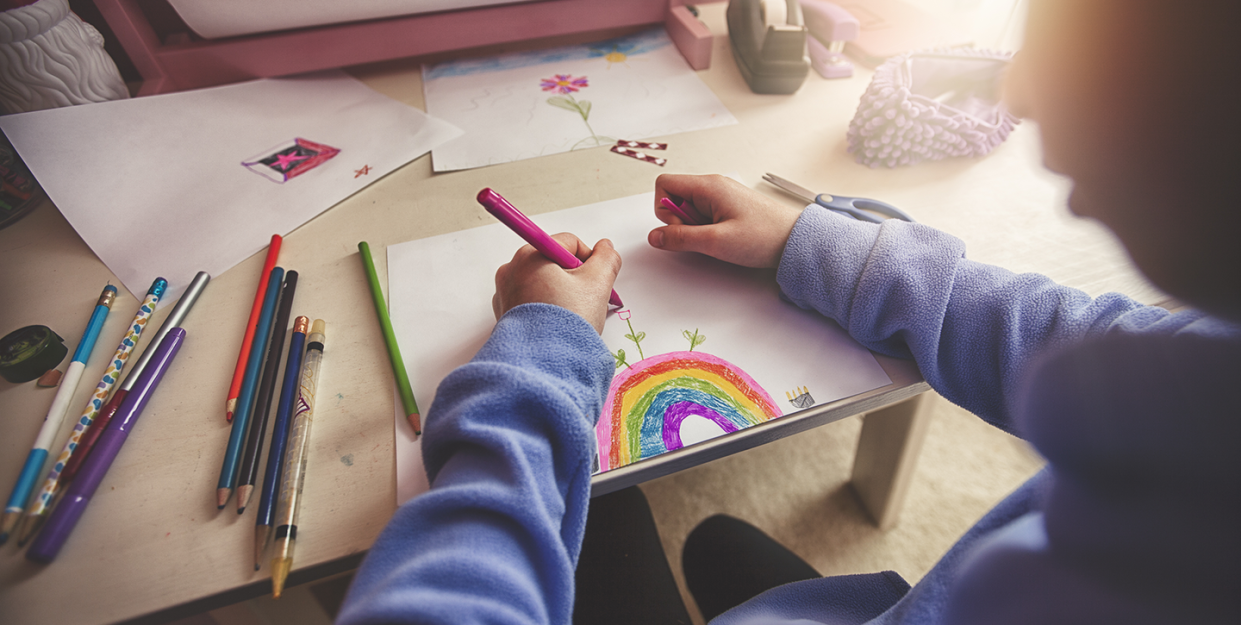Creativity Isn't Something Children Are Born With, It's Something Parents Can Teach

"Hearst Magazines and Yahoo may earn commission or revenue on some items through the links below."
I was a very dreamy kind of kid, the type who was always drawing. I created a family newspaper at a young age and, with an equally artsy pal down the block, I’d make up stories and write plays and songs to perform for the neighborhood parents. Whether it was because I was the youngest in a busy family or because I was raised in the days before kids had full slates of extra-curricular activities, my parents gave me lots of unstructured free time to explore, hang around outside and, yes, be bored. But when an interest stuck, they’d help find resources to dive into it further, like classes or related museums and performances.
Today I’d say the number one characteristic I’d use to describe myself as an adult is creative. I write as a profession, and outside of work I still enjoy drawing and painting. But most of all, I love to come up with creative approaches to everyday problems. Not surprisingly, I was always interested in how to help my own kids find their creative selves, too. And I’m pretty sure it worked: one became an actor and the other developed a passion for rock climbing, the ultimate problem-solving athletic pursuit.
But I had to wonder: Was creativity something I passed down to them, or did they grow to be creative people because it was something we valued as a family? And can creativity be worked on like any other skill?
“The reality is that creativity is fostered over time,” says Andres S. Bustamante, Ph.D., Assistant Professor of Human Development in Context at the School of Education of the University of California, Irvine. Experts agree that, in fact, creativity can be taught or developed. Yet popular misconceptions about creativity abound, chief among them that some people are born innately more creative than others.
“Once you realize that creativity is all about what you do and how you do it,” says Dona Matthews, Ph.D., a Toronto-based psychologist specializing in gifted children and the founding director of the Hunter College Center for Gifted Studies and Education, City University of New York, “you realize that everyone can learn to be creative, no matter their age or personality.”
So what exactly is creativity, and why is it important for kids?
“Creativity is the ability to generate or recognize ideas, alternatives or possibilities for solving problems, communicating or entertaining,” says Ben Michaelis, Ph.D., a Manhattan-based clinical psychologist who helps patients achieve mental health and well-being through creativity.
Dr. Bustamante says that the most common way that researchers measure creativity in children is through something called divergent thinking. Children are given a challenge to see how many possible solutions to a problem or task they can generate; for instance, they might be given several different materials and asked to get a ball out of a jar in as many ways possible.
Experts agree that at a time of escalating concerns about children’s mental health, it has never been more important to focus on fostering creativity in our kids. “The academic literature has consistently shown that people who think more creatively are happier, less likely to get depressed, less likely to get sick, and so on,” says Dr. Michaelis.
Dr. Matthews says this is, in part, because problem-solving helps foster resilience, “Evidence is accumulating that creative self-expression can be a powerful force for supporting children’s coping skills.” In a major 2017 study investigating the role of the arts in health, she says, the National Organization for Arts in Health (NOAH) provided ample confirmation of the important role the arts can play in physical and mental health.
Then, too, creativity and problem-solving rank high on the list of skills sought by employers in the contemporary global marketplace. “In a 21st century society where all the facts and knowledge in the world are available to everyone through a quick Internet search,” Dr. Bustamante says, “the most valuable skills are those that allow you to be flexible, adaptable and solve dynamic problems as they arise.”
Parents can help spark their kids’ creativity.
Since creativity builds up over time, there isn’t just one way a parent can flip a kid’s switch from “not creative” to “creative.” Still, there are things families can do to help build creativity little by little:
✔️ Slow it down, unplug, and lighten up the schedule. “Make sure your child has the time they need for unstructured play, do-nothing times, outdoor play, daydreaming and dawdling,” says Dr. Matthews. If that means pushing back against extracurriculars, she says, do it. “Creativity can only emerge when your child’s brain has time and opportunity — with no distractions or commitments — to play with what they’re learning and transform knowledge into fresh ideas,” she explains.
✔️ Allow time and space for play. “The best way to foster creativity and exercise their imaginations in a child is through play,” says Dr. Bustamante. “Dramatic play, imaginative play, outdoor play, board games and sports all have unique value and develop different skills.” Since creativity is about finding new solutions to a problem and self-expression, he says, “when children play — especially with others — they are presented with all types of challenges, and they’re given the agency to solve them using their imagination while expressing their interests and talents.”
In addition to playing with kids, parents should learn how to be good play partners. “Sometimes well-intentioned parents will ‘co-opt’ play with too many closed-ended questions — those that are answered by a yes or no — or by being too directive,” Dr. Bustamante says. Instead, lean into open-ended questions. Try: “Wow, what a beautiful building! What’s it for?” instead of “Is that a fire station?” This lets them put their imaginations to work.
✔️ Listen to your child’s interests and support their passions. “Ask questions and help them take it farther, supporting them in developing their curiosities and interests into abilities,” says Dr. Matthews. This doesn’t mean running out and enrolling them in art classes. Start by making sure you have ample paper, crayons and age-appropriate art supplies on hand. By nurturing your child’s curiosity and helping them take their interests further, she explains, “you open their mind to options and ideas that are the building blocks of creative possibility.”
✔️ Encourage patience, persistence, and hard work. “Support your child in following through on their interests, staying with their curiosities, and working through their failures,” says Dr. Matthews. “If they quit as soon as they hit a roadblock, or settle for quick, superficial accomplishments, they won’t experience the fulfillment of true creativity. When they become habits of mind — and that happens with practice — interests become abilities, which become strengths. And that is the source of intelligence, creativity, and genius.”
✔️ Create opportunities for creative self-expression. “Support your child in expressing themself openly and without judgment, in whatever medium is most appealing, whether it’s writing, painting, drama, role-playing, music, puppetry or dance,” says Dr. Matthews. Once they’ve completed their work, she says, listen to what they tell you. “A child who learns to express their feelings creatively is experiencing firsthand the joys and power of creativity,” she says, “Then they’re much more likely to look for more opportunities for creative self-expression and application to what they are learning.”
✔️ Support your child in building a network of social support. When they’re in a group, such as a theater class or dance troupe, they’ll have plenty of opportunities to problem-solve as a group. Your child can see different ways of approaching an obstacle, which will help them work on their own resistance.
To boost creativity, try playing one of these games.
Dr. Michaelis says these games will have kids looking at the world in a new way.
✔️ Turn familiar objects upside down — literally. “When you look at things right-side up, your left ‘verbal’ brain quickly labels it and diverts your attention elsewhere,” explains Dr. Michaelis, “When they’re upside down, your right brain network kicks in, trying to interpret the shapes, colors and relationships of a puzzling picture.” Try turning framed pictures of your family upside down and see how long it takes your kids to notice. Similarly, art teachers often ask their students to copy a drawing after it’s been turned upside-down, saying that students then have to draw what they really see, not what they think they should be sketching.

✔️ Play “10 Things.” For this game, someone hands you an ordinary object, and you must say 10 different “things” that the object might be. “Forcing your brain to think of alternates to the everyday will help keep it strong,” Dr. Michaelis says. For example, a fly swatter might be a tennis racket, a fan, a baton, a microphone, etc. Interestingly, for an episode about creativity on the Netflix series Brainchild, the show’s hosts played this game with people on the street. (The object was a ketchup bottle.) For their very laid-back experiment, participants did better if they darted their eyes back and forth before they played. The show’s hosts claimed that the eye movement helped connect the left and right brains, giving players a momentary boost of creativity.You could run the same experiment at home when you play your own version of “10 Things.” — try it without the eye movement first, then see if the eye movement helps loosen up more ideas.
✔️ Try fast-paced logic-based games. “Logic games like SET or Rush Hour create new neural connections,” Dr. Michaelis explains. The best tasks for the brain are not only challenging, but they are varied and novel, he continues, like Sudoku, online quizzes or memory-recall games.
Don’t let the drive for creativity backfire.
The same way families can foster creativity in their kids, they can also squash it. If it’s possible, try to avoid these creativity killers.
✔️ Don’t overschedule your child. Make sure there’s lots of time for free play, daydreaming and exploration. “They try different things, they make mistakes — it can’t be all stuffing things into your brain,” says Dr. Matthews. “The novelty generator needs a chance.” Even boredom can be an obstacle to be overcome, which lets kids flex those problem-solving muscles.
✔️ Avoid telling your child that they’re creative, or an artist, dancer, etc. Instead, be targeted and specific in your praise, recommends Dr. Matthews. “Say things like, ‘I love how you mixed the colors in this painting,’ or ‘I can hear the results of your hard work practicing when you play the piano.’”
✔️ Stop imposing your own interests on your child. Instead, ask them questions, listen to their answers, and support them in following their curiosity wherever it goes.
“As you approach the activities in your child’s life more creatively,” says Dr. Matthews, “their creative abilities strengthen, which is what Maya Angelou was talking about when she wrote, ‘You can’t use up creativity. The more you use, the more you have.’” And, Dr. Matthews adds, “Just like kindness or gratitude, creativity can be developed at any age.”
You Might Also Like

